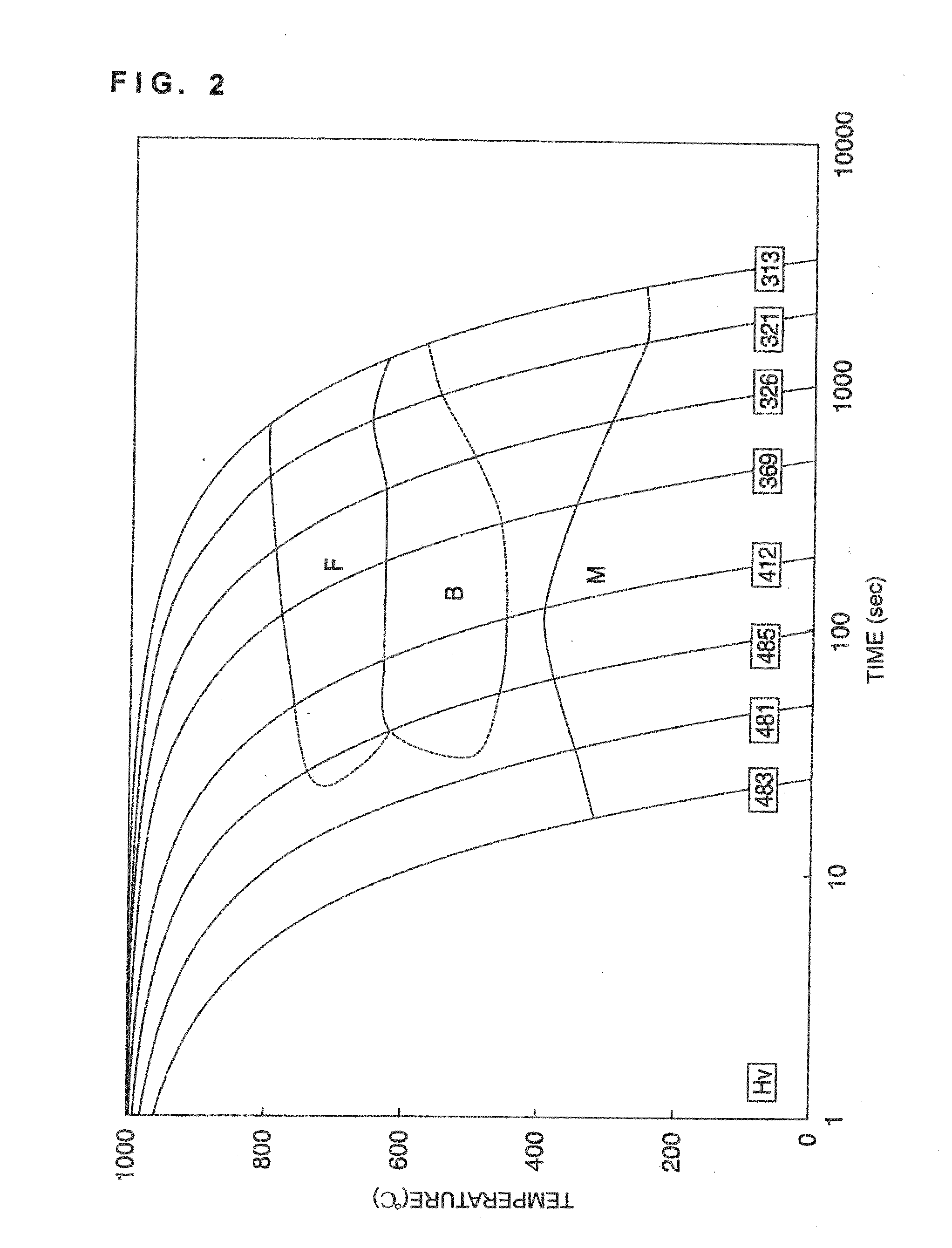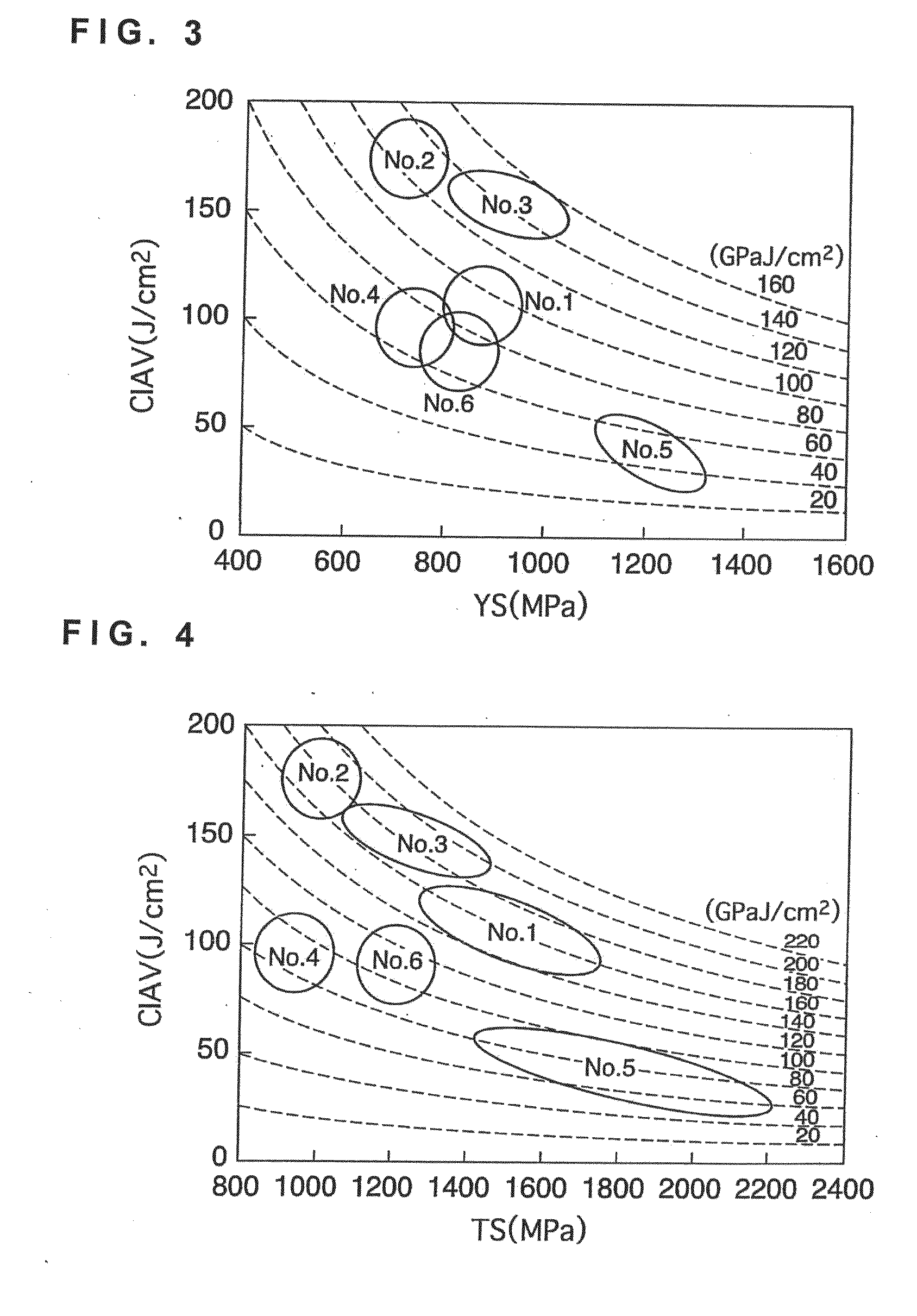High-Strength Steel Machined Product and Method for Manufacturing the Same, and Method for Manufacturing Diesel Engine Fuel Injection Pipe and Common Rail
a high-strength steel, machined technology, applied in the direction of manufacturing tools, furnaces, heat treatment equipment, etc., can solve the problems of large amount of unstable retained austenite, increased hardenability, and deterioration of impact resistance, so as to improve strength and fatigue strength, the effect of ultra-high
- Summary
- Abstract
- Description
- Claims
- Application Information
AI Technical Summary
Benefits of technology
Problems solved by technology
Method used
Image
Examples
example 1
[0057]The testing steel slabs of Steel grades Nos. 1 to 6 having the respective compositions given in Table 1 (the unit in Table 1 is % by mass, and the balance is Fe and inevitable impurities), were formed by continuous casting. They were reheated to a 1250° C. region, hot-rolled, pickled, and then machined to form the respective specimens for forging in the shape of square bar of 20 mm in thickness, 80 mm in length, and 32 mm in width through the use of steel bar of 32 mm in diameter and 80 mm in length.
[0058]Then, for each testing steel grade, each specimen for forging was heated to the respective forging temperatures given in Table 2 for 1 second or longer period to thereby perform forging processing by using a mold which was heated to the same temperature as the heating temperature of the specimen, and thus 10 to 70% of compression forging strain was provided. After that, the specimen was cooled to the austempering temperature given in Table 2 at an average cooling rate of 1° C...
example 2
[0076]A billet of the steel of the present invention, having the composition of Steel grade No. 1 in Table 1, was heated to and held at 1200° C., which was then subjected to hot-extrusion. The extruded billet was cooled to 940° C. and was held at the temperature for 1 second or more, which was then subjected to a specified warm-extrusion to form a round bar. The round bar was cooled to 325° C. at a cooling rate of 4° C. / s, which was then held at the temperature for 1800 seconds. The cooled round bar was further cooled to room temperature at a specified cooling rate. After that, the round bar was treated by gun-drill machining for drilling the steel bar in the axial direction thereof to form a base pipe of fuel injection pipe. The base pipe was treated by tube-working to obtain a steel pipe for fuel injection pipe having 8.0 mm in outer diameter, 3.0 mm in inner diameter, and 2.5 mm in thickness. The pipe was cut to a specified length, to which cut pipe a threaded component such as n...
example 3
[0077]A billet of the steel of the present invention, having the composition of Steel grade No. 2 in Table 1, was heated to and held at 1250° C., which was then subjected to hot-extrusion. The extruded billet was cooled to room temperature, which was then treated by gun-drill machining for drilling the steel bar in the axial direction thereof. The drilled pipe was held at 950° C. for 1 second or more, and then was subjected to hot-rolling. The pipe was cooled to 375° C. at a cooling rate of 2° C. / s, and then was subjected to austempering to hold at the temperature for 1000 seconds. Furthermore, the pipe was treated by cold-tube-working to obtain a pipe having 8.0 mm in outer diameter, 3.0 mm in inner diameter, and 2.5 mm in thickness. The pipe was treated by being cut to a specified length, edge-machining, and bending the pipe, thus being obtained the steel pipe for fuel injection pipe.
PUM
| Property | Measurement | Unit |
|---|---|---|
| temperature | aaaaa | aaaaa |
| temperatures | aaaaa | aaaaa |
| pressurizing temperature | aaaaa | aaaaa |
Abstract
Description
Claims
Application Information
 Login to View More
Login to View More - R&D
- Intellectual Property
- Life Sciences
- Materials
- Tech Scout
- Unparalleled Data Quality
- Higher Quality Content
- 60% Fewer Hallucinations
Browse by: Latest US Patents, China's latest patents, Technical Efficacy Thesaurus, Application Domain, Technology Topic, Popular Technical Reports.
© 2025 PatSnap. All rights reserved.Legal|Privacy policy|Modern Slavery Act Transparency Statement|Sitemap|About US| Contact US: help@patsnap.com



